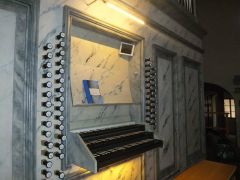Yiorgis Sakellariou is a composer of experimental electronic music. Since 2003, he has been active internationally, creating solo and collaborative albums, music for short films and theatrical performances, leading workshops and ceaselessly performing his music around the globe.
His practice is founded on the digital manipulation of environmental recordings. His palette of sounds is all-encompassing from vibrating train rails to refrigerator static, and from noisy waterfalls to the humming of insects. He only performs in absolute darkness, fostering an all-inclusive and profoundly submersive sonic experience.
His current research as a PhD student at Coventry University explores the relationship between electroacoustic music and the use of sound in rituals.
Yiorgis Sakellariou is a member of the Athenian Contemporary Music Research Centre and the Hellenic Electroacoustic Music Composers Association. Since 2004 he has curated the label Echomusic.
Residency Project
In 1980, Jonathan Harvey composed Mortuos Plango Vivos Voco, arguably his most significant work. The piece is based on two sounds: the tenor bell at Winchester Cathedral in England and the voice of the composers' son, who was a chorister there. The sounds were digitally processed at IRCAM in Paris and resulted to an octaphonic electroacoustic composition.
In a similar manner, Sakellariou proposed the composition a new piece based on sounds of churches in Prague. Aside from bells, he mainly recorded the churches’ sonic atmospheres; the silences, the creaking of wooden chairs, the water dripping down the pipes and any other distinguishable sound element he discovered. Moreover, he explored the buildings’ resonances by playing the church organs, which replaced the voice as an organic and musical element in the composition.
As in Harvey’s work, the transformation of sounds for his piece aims at expanding their physical boundaries without necessarily losing their sonic identity. Using technology in an exploration of the threshold of sonic perception, and not simply a technique of producing an object.
Nietzsche claimed that galleries and concert halls have replaced churches as places where the divine can be encountered. The purpose of Sakellariou’s work at Školská was to investigate this idea and see how it could be applied to contemporary sound works. The piece also researched the profound nature of contemporary technology. Through the act of field recording, the sounds of churches had been relocated to the gallery space, re-enabled and limited through an act of resurrection which will negotiate their ethereal nature and impact on the listener. Moreover, he investigated the notion of silence as space, temporal and transitory, and add questions into the general discourse about sound works in galleries and the differences between installations and time-based compositions.
The residency of Yiorgis Sakellariou was supported by the Agosto Foundation.





